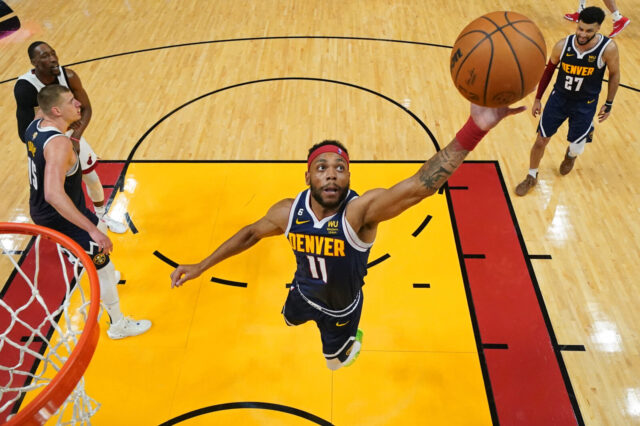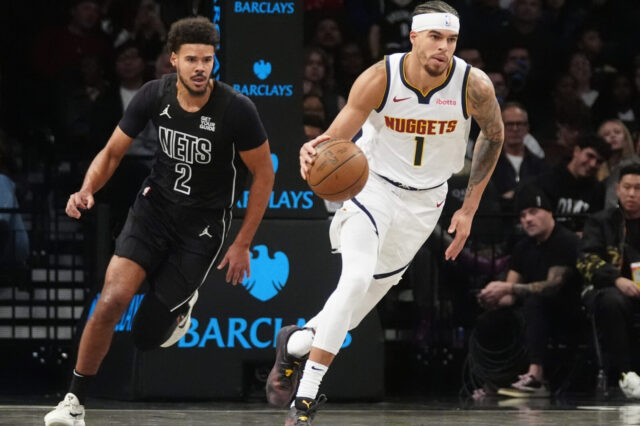When Brian Shaw was introduced as the head coach of the Denver Nuggets in 2013 he spoke to the media about the new direction he had planned for the team. In his press conference he mentioned that he wanted to move the team away from the run and gun style that they had been known for under George Karl and become a team that focused on half court execution.
…with my experience with the Lakers is that playing and coaching against the Phoenix Suns when they won 60 games in a season, playing the up and down style that it doesn’t necessarily translate well when you get to the playoffs. One of the areas that I want to kind of strengthen is, obviously we will still want to attack and get up and down the floor, but the ability to play in the half court and execute in the half court because that is where you get judge on in the playoffs.
– Brian Shaw 6/25/13
The implication was clear. He didn't mind playing at a fast pace on occasion, but the Nuggets needed to lean on execution when the game slowed down and the fast breaks are taken away. 500 days into Shaw's tenure we have enough of a sample size to evaluate how that process is panning out.
Through Monday, the Nuggets are 4th in pace at 96 possessions per game and 7th in fast break points. For reference, in 2012-13 under Karl the Nuggets were 2nd in pace and 1st in fast break points. The team appears to have slightly de-emphasized fast break scoring although they are still comfortably in the top third of the league in that category.
Digging deeper we find that per SportsVu, the Nuggets take the 3rd most FGA in the first 8 seconds of the shot clock. For our purposes, we will refer to these attempts as early in the shot clock. Nearly 33% of all Nuggets FGA take place early while the league average is just around 26%. These FGA are not solely fast break attempts but rather a combination of fast break attempts, points in transition, offensive rebound putbacks, and a fairly small sampling of late game or late quarter two-for-one opportunities. As a general rule, FGA in the early part of the shot clock are far and away the most efficient shots in the game. Defenses aren't always set and teams can exploit mismatches or catch a rotating defender off guard before they have a chance to get set on defense. On average, teams shoot 7.5% better in the first third of the shot clock than they do in the second or final third and teams on average take roughly one quarter of their shots early in the shot clock.
While the Nuggets take the 3rd most FGAs early in the shot clock, they rank 19th in eFg% on those shots. That ranking seems low for a team that takes them with such frequency but that is actually the team’s highest eFg% when you break down the team’s FGA into thirds of the shot clock.
The Nuggets rank 25th in the league in eFg% for shots that fall between 8 and 16 seconds on the shot clock. We’ll call these mid shot-clock FGAs. These shots are usually the product of a team’s offensive system. It generally takes 5-7 seconds to dribble up the court and initiate a play and another 5-10 seconds for that play to fully develop. These mid shot-clock attempts make up a majority of a team’s attempts and 45% of all Nuggets attempts occur somewhere in this range.
Lastly there are late shot-clock attempts. For these attempts it is best to break them down into late attempts, all attempts with eight seconds or less on the shot clock, and very late attempts which are all attempts with less than four seconds on the shot clock. These attempts are largely impacted by two factors: offensive execution and strong individual playmaking. Teams that rank higher in this category tend to either have refined offensive systems that produce good looks late in the shot clock, or excellent individual scorers who can create good looks for themselves or teammates when a play falls apart.
The Nuggets are particularly bad at late and very late attempts, ranking 29th and 30th respectively. These FGAs are particularly interesting because they are exactly the type of attempts that Shaw talked about emphasizing when he took over the job nearly two summers ago. These are the "grind it out" plays that he stressed as important for true team success. These were the shots that Shaw believed were the cornerstone to developing a championship system.
He wasn't wrong. If you look at the rest of the league, the Warriors, Hawks and Spurs rank one, two and four respectively in eFg% very late in the shot clock. The Hawks and Spurs also rank two and four in percentage of FGA that come very late in the shot clock. It is specifically by design that they attempt and make so many shots this way. Their offenses are designed to get them good opportunities after making the defense work for 24 seconds. One way that they do this is by transitioning from their initial set into a second set very quickly.
In this clip, the Hawks run their transition set which has one forward or center rim-run to the post while the other big trails the play. The ball swings to the trailing big who has a series of options. He can look to drive and score, he can enter it to the post if it's open, he can reverse it or he can get it back to the point guard. In this case, since Kyle Korver is being denied the reversal, Korver cuts through to the opposite corner and the ball swings back to the point guard. Phase one of their offense is complete. They didn't produce a shot but they were able to check off a few options while making the defense react for 10 seconds. But the incredible part of their offense is how seamlessly they transition from phase one to phase two; a set out of HORNS. As Korver cuts to the corner, the other players quickly get into HORNS formation and a new action is initiated.
It isn't necessarily the most earth shattering play, but Mike Budenholzer, the Hawks head coach who was hired the same summer as Shaw, has developed a system that breaks an offensive possession into two parts. The first part is a push to get a transition basket using a variety of options out of their basic set. The second half of the shot clock is used to run a different set. When the two parts of a possession transition together seamlessly it gives the appearance of one smooth possession while forcing the defense to make reads for 24 seconds.
This is the offensive execution that Shaw hinted at when he spoke to the Denver media for the first time back in 2013. It's an offense that looks to get quick easy buckets. An offense that understands the value of FGAs early in the shot clock but doesn't run for the sake of running. An offense that executes their primary set but doesn't force up a shot if it isn't open. An offense that seamlessly transitions from one set to the other to maximize each possession and grind out points deep in the shot clock.
It's an offense that Shaw aspired to but unfortunately one that is a polar opposite of what he has helped produce with the Nuggets over the last two seasons. The Nuggets offense gets worse the longer the possession lasts. The team tends to get into one set, if that, per possession and those sets tend to have very few reads and/or options. Admittedly the team lacks the talent or versatility that teams like the Spurs, Hawks and Warriors have and the team shouldn't be judged on their eFg% alone. But the signs of a good offense should, at the very least, start to develop and show signs of growth and improvement. After 500 days as head coach of the Nuggets, that goal just hasn't been met.
* Shot clock eFg% and FGA frequency data courtesy of @SethPartnow, Nylon Calculus.
** The shot clock data is current through 1/19/15
*****
Reminder: Our next Stiffs Night Out is happening THIS Wednesday beginning at 5:30pm as the Nuggets take on the Pelicans in New Orleans. As our first-ever Happy Hour SNO, Jake’s Food & Spirits (3800 Walnut Street) will be our host and will serve up 50-cent wings and happy hour drink prices throughout the game.
This will be my first ever Stiffs Night Out and I really look forward to meeting you all and discussing our beloved Nuggets. I hope to see you there!
****





